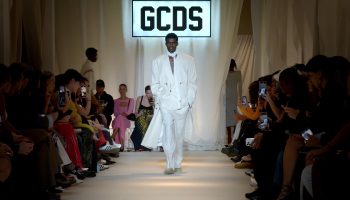This post is also available in: Italiano
It still cannot be said that it has entered common usage to talk about Second Life.
Yet, the digital world to be inhabited, in which experiences and content can be created, is already a reality.
We are talking about Metaverse: a term coined by Neal Stephenson in Snow Crash (1992), a cyberpunk science fiction book, described as a kind of virtual reality shared via the Internet, where one is represented in three dimensions through one’s avatar.
The Fashion world, of course, has also lived in the Metaverse for a while, and brands that do not now commit to buying or renting a home here risk missing out on opportunities for strategy and business development in a rapidly evolving space.
Follow me, today I am talking about this.
l Metaverse: what is it?
Stephenson defines the Metaverse as an immense black sphere 65536 km (216) in circumference, cut in two at the height of the equator by a road that can also be traveled on a monorail with 256 28) stations, each 256 km (226 miles) apart.
On this sphere any person can make in 3D what he or she wants, stores, offices, nightclubs and more, all of which can potentially be visited by users.
A futuristic vision of the modern Internet, frequented by the middle and upper segments of the population, where the difference between social classes is represented by the resolution of one’s avatar (from the black-and-white ones of public terminals, to the 3D ones of the rich) and the ability to access exclusive places.
Throughout the Fashion industry, especially big brands, are experimenting with the Metaverse by launching NFTs, digital storefronts and virtual avatar products.
In the same vein as Decentraland or Roblox, powerful P2P facilities that enable the virtual world to be resilient, the fashion industry, which has always been ready to embrace technological innovation, is also experimenting with Web3, launching NFTs, digital storefronts and virtual avatar products.
But to make digital copies “live decently” in the Metaverse, the way they appear online must be rethought.
This was taken care of by luxury brands such as Gucci and Balenciaga, Etro and Dolce & Gabbana, who presented their collections at Metaverse Fashion Week.

The Metaverse: where are we today?
The development of the Metaverse is practically in its infancy, but waiting means missing opportunities for learning and relationship building.
Brands should not enter the Metaverse just because it is an interesting prospect, but rather because it is where consumers are already and conversations are already happening.
The world of Fashion and the Metaverse share a number of things: as a driving force, it is fun and a taste for experimentation.
Moreover, the industry, usually run directly by its creators entertaining followers on social media, can now easily translate to discussions held directly in web spaces3.
The Metaverse in the Fashion Industry
The fashion industry is already known for intense research and in the adoption of ever-new technologies, such as augmented reality, which in part emulates the Metaverse, so that consumers can virtually wear clothing and clothing accessories and buy as if they had tried it on first in the store fitting room.
In short, the potential for new business and consumer engagement methods, is there. But the Metaverse is still underdeveloped.
Brands, graphic designers, consumers and developers are still in the dark about what will be in the years to come, even in the short term.
However, the bold and enterprising recognize that it is better to experiment than to fall behind.
A note of comfort for the more traditionalists: fear not, the catwalks will not disappear, nor will the stores familiar to you. A slice of the industry will simply evolve.
Behind the scenes, then, there are (thankfully) always them, the mainstays: tailors and the traditional manufacturing industry, without which Metaverse and Augmented Reality would have no reason to exist.
The NFT experiments
Translating fashion into the Metaverse is not as simple as creating digital counterparts of physical products.
This difficulty leaves room for creativity and experimentation, allowing brands to create digital products that tell their story online through an experience about the brand, or about the products themselves.
To give you a concrete example, Alex Box (British beauty futurist make-up artist) accepted a commission from beauty company Estée Lauder to create an NFT based on their Advanced Night Repair product, to be presented at Metaverse Fashion Week.
To accomplish the task, Box thought about the product in its entirety, its history, its ingredients, and how its patron wants its consumers to feel when they use the product, rather than what it does.
The NFT generated was not just a digital copy of the product, but an actual filter that coated Estée Lauder avatars with a radiant effect.

Instead of a binary representation, you can get into the essence of what is. You have a 360-degree, immersive communication tool that was not there before.
Alex Box
How to join the Metaverse?
For starters, brands should consider creating their own virtual storefronts, which may or may not be built on the blockchain, said Jordan Robinson, director of the Metaverse MA+Group, which helped create virtual storefronts for Kylie Cosmetics and Armani Beauty, adding that it is not necessary to focus on a single platform.
Another item that needs to be included in a company timeline right away is the launch of NFTs attached to loyalty programs, which, according to Melissa Kelly, chief operating officer of MA+Group, have tremendous potential for community generation in the industry.
Clinique ci ha creduto e ha fatto proprio questo nel 2021, dando ai vincitori di un concorso un NFT a forma di molecola basato sui prodotti Moisture Surge moisturiser e Black Honey Lipstick, insieme a un assortimento annuale di prodotti tradizionali, per il prossimo decennio. believed in it and did just that in 2021, giving contest winners a molecule-shaped NFT based on the Moisture Surge moisturiser and Black Honey Lipstick products, along with an annual assortment of traditional products, for the next decade
According to Fashion industry trade magazine WWD‘s report, Women’s Wear Daily, in February, Clinique experienced a 60 percent increase in search traffic and a 20 percent increase in social media audience.
The Metaverse: a new opportunity
Il MeThe Metaverse is also a new opportunity for brands: brands can learn the needs of their customers through the Metaverse and apply it to the development of new products.
So did the British perfume brand Rook, gave 30 customers access to a DAO (a decentralized autonomous organization, i.e., a collective in which members share ownership and participate through blockchain-based tokens) that, over the course of six months, collaborated on the development of a new fragrance called The Scent of the Metaverse, now for sale on the site. DAO members receive a portion of the sales.
Conclusions
With the Metaverse, we envision a world in which brands will also have their locations on a Web3 platform, just as they already do today on social media.
Resources are needed that understand the semantics, limitations and possibilities, long and short term, of different platforms, that build real scripts, no longer just digital clones of a physical product.
This is the beginning of a whole new era of digital experience, an opportunity to push the boundaries of consumer engagement.
It is good for brands to start thinking about how to appear in metaverse spaces as soon as possible.
Forewarned is forearmed 😉







